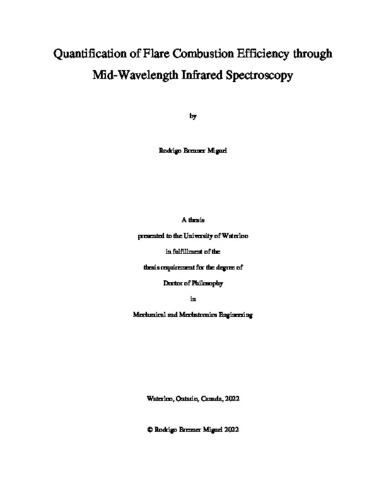| dc.description.abstract | Flares convert unwanted hydrocarbon emissions into carbon dioxide to be disposed into the atmosphere. Although this conversion reduces the oil and gas industry’s greenhouse gas inventory, it is still responsible for significant anthropogenic carbon dioxide emissions. In the case of incomplete combustion, the flare emits unburned fuel, increasing the greenhouse footprint, environmental damage, and possibly presenting a local hazard. The efficiency with which the hydrocarbons are transformed into carbon dioxide, called the combustion efficiency, is assumed to be higher than 98%. However, in some circumstances, combustion efficiency may be reduced significantly.
Mid-wavelength infrared spectroscopy is well suited for fenceline measurements of flare combustion efficiency. As the emission from flares may not be well mixed due to the mechanisms that create the inefficiencies, mid-wavelength infrared cameras make it possible to observe the two-dimensional effects of the three-dimensional concentration field of the species. This study investigates the use of multispectral and hyperspectral mid-wavelength infrared cameras to quantify flare combustion efficiency.
This dissertation begins with a review of the flaring process. Most flaring occurs in the production phase and is used to burn unwanted associated gas from oil extraction. Production flares are susceptible to ambient conditions, and wind can decrease flare efficiency. The dissertation continues with a derivation of the measurement model that relates the measured spectral camera irradiance to the flare plume, and how the model is inverted to infer the column density of gas corresponding to each camera pixel. These column densities are combined with a velocity field obtained from an optical flow algorithm to calculate the species mass flow, and, thereafter, the flare combustion efficiency.
At least one independent signal is necessary to infer each parameter needed to compute flare combustion efficiency. In the case of multispectral cameras, the number of signals is limited, and the spectral bands need to be carefully selected to generate independent signals. A technique for selecting optimal filters for a multispectral camera to measure flare combustion efficiency is presented. Filter sets are ranked in terms of the change in the combustion efficiency to the change in measurement noise. Synthetic data are generated using the resulting species concentration and temperature from a simulated flare-in-crosswind. The methane and carbon dioxide concentrations, as well as temperatures, are estimated using commercially-available filter sets. The estimated parameters are transformed to combustion efficiency and compared using error propagation. The optimal filters are aligned with the methane and carbon dioxide absorption bands, emphasizing the methane lines.
The potential of using imaging Fourier transform spectrometers (IFTS) is next assessed to measure the combustion efficiency. The species mass flows are estimated by combining species column densities estimated from a spectroscopic model with intensity-weighted velocities found using optical flow. Simulated measurements using a computational fluid dynamics (CFD) large eddy simulation of a flare in a crosswind are used to establish the technique’s viability, followed by experimental measurements on a heated gas vent. Finally, preliminary measurements are carried out on laboratory-scale steam- and air-assisted flares. While the simulated measurements and heated vent experiments support the feasibility of this approach, experimental spectra from the lab-scale flare were contaminated with anomalies, which complicates the quantitative interpretation of the measurement data.
Obtaining the concentration distribution of combustion products from spectroscopic data is challenging due to the many variables involved and the indirect relationship between the measured spectra and the unknown quantities. These effects often make the inference problem mathematically ill-posed and computationally demanding to solve. The dissertation examines how incorporating a thermochemical manifold reduction (TCMR) mechanism into the inference procedure reduces the number of unknown parameters, decreasing the ill-posedness of the problem and the computational cost of solving it. The approach is demonstrated on synthetic images from the CFD data. The information introduced by the TCMR improved the carbon dioxide column density accuracy and precision for all tested wavenumber resolutions in relation to a full regression, with a more pronounced improvement for pixels having a larger column density. On the other hand, there is no significant change in estimating the concentrations of unburned fuel.
Optical gas imaging has the potential to estimate flare combustion efficiency. The IFTS demonstrated good accuracy in the numerical and part of experimental tests. Additionally, in the tests on the lab-scale flares, the IFTS-inferred combustion efficiency agreed with the expected trends, excluding plumes rich in soot. Although numerical experiments showed that the multispectral camera was inferior to the IFTS, it is significantly less expensive and insensitive to turbulence effects that complicate interpretation of the IFTS spectra. | en |

